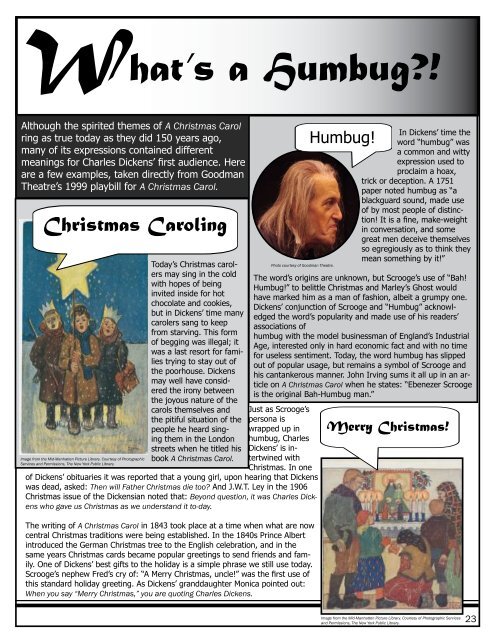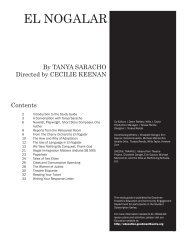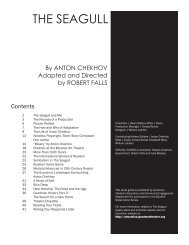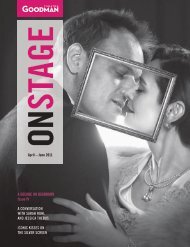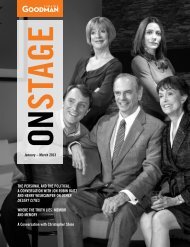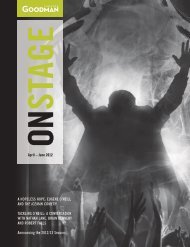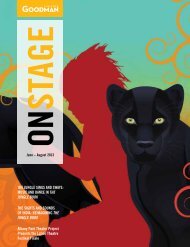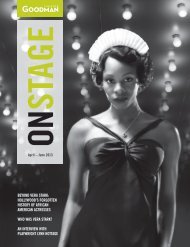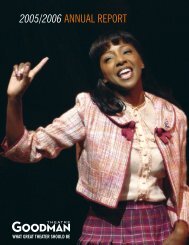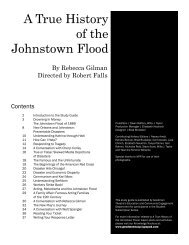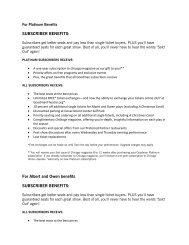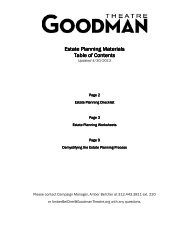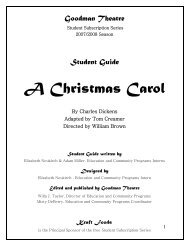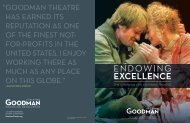A Christmas Carol Study Guide.indd - Goodman Theatre
A Christmas Carol Study Guide.indd - Goodman Theatre
A Christmas Carol Study Guide.indd - Goodman Theatre
You also want an ePaper? Increase the reach of your titles
YUMPU automatically turns print PDFs into web optimized ePapers that Google loves.
What’s a Humbug?!<br />
Although the spirited themes of A <strong>Christmas</strong> <strong>Carol</strong><br />
ring as true today as they did 150 years ago,<br />
many of its expressions contained different<br />
meanings for Charles Dickens’ first audience. Here<br />
are a few examples, taken directly from <strong>Goodman</strong><br />
<strong>Theatre</strong>’s 1999 playbill for A <strong>Christmas</strong> <strong>Carol</strong>.<br />
<strong>Christmas</strong> <strong>Carol</strong>ing<br />
Image from the Mid-Manhatten Picture Library. Courtesy of Photographic<br />
Services and Permissions, The New York Public Library.<br />
Today’s <strong>Christmas</strong> carolers<br />
may sing in the cold<br />
with hopes of being<br />
invited inside for hot<br />
chocolate and cookies,<br />
but in Dickens’ time many<br />
carolers sang to keep<br />
from starving. This form<br />
of begging was illegal; it<br />
was a last resort for families<br />
trying to stay out of<br />
the poorhouse. Dickens<br />
may well have considered<br />
the irony between<br />
the joyous nature of the<br />
carols themselves and<br />
the pitiful situation of the<br />
people he heard singing<br />
them in the London<br />
streets when he titled his<br />
book A <strong>Christmas</strong> <strong>Carol</strong>.<br />
Photo courtesy of <strong>Goodman</strong> <strong>Theatre</strong>.<br />
Just as Scrooge’s<br />
persona is<br />
wrapped up in<br />
humbug, Charles<br />
Dickens’ is intertwined<br />
with<br />
<strong>Christmas</strong>. In one<br />
of Dickens’ obituaries it was reported that a young girl, upon hearing that Dickens<br />
was dead, asked: Then will Father <strong>Christmas</strong> die too? And J.W.T. Ley in the 1906<br />
<strong>Christmas</strong> issue of the Dickensian noted that: Beyond question, it was Charles Dickens<br />
who gave us <strong>Christmas</strong> as we understand it to-day.<br />
The writing of A <strong>Christmas</strong> <strong>Carol</strong> in 1843 took place at a time when what are now<br />
central <strong>Christmas</strong> traditions were being established. In the 1840s Prince Albert<br />
introduced the German <strong>Christmas</strong> tree to the English celebration, and in the<br />
same years <strong>Christmas</strong> cards became popular greetings to send friends and family.<br />
One of Dickens’ best gifts to the holiday is a simple phrase we still use today.<br />
Scrooge’s nephew Fred’s cry of: “A Merry <strong>Christmas</strong>, uncle!” was the first use of<br />
this standard holiday greeting. As Dickens’ granddaughter Monica pointed out:<br />
When you say “Merry <strong>Christmas</strong>,” you are quoting Charles Dickens.<br />
Humbug!<br />
In Dickens’ time the<br />
word “humbug” was<br />
a common and witty<br />
expression used to<br />
proclaim a hoax,<br />
trick or deception. A 1751<br />
paper noted humbug as “a<br />
blackguard sound, made use<br />
of by most people of distinction!<br />
It is a fine, make-weight<br />
in conversation, and some<br />
great men deceive themselves<br />
so egregiously as to think they<br />
mean something by it!”<br />
The word’s origins are unknown, but Scrooge’s use of “Bah!<br />
Humbug!” to belittle <strong>Christmas</strong> and Marley’s Ghost would<br />
have marked him as a man of fashion, albeit a grumpy one.<br />
Dickens’ conjunction of Scrooge and “Humbug” acknowledged<br />
the word’s popularity and made use of his readers’<br />
associations of<br />
humbug with the model businessman of England’s Industrial<br />
Age, interested only in hard economic fact and with no time<br />
for useless sentiment. Today, the word humbug has slipped<br />
out of popular usage, but remains a symbol of Scrooge and<br />
his cantankerous manner. John Irving sums it all up in an article<br />
on A <strong>Christmas</strong> <strong>Carol</strong> when he states: “Ebenezer Scrooge<br />
is the original Bah-Humbug man.”<br />
Merry <strong>Christmas</strong>!<br />
Image from the Mid-Manhatten Picture Library. Courtesy of Photographic Services<br />
and Permissions, The New York Public Library.<br />
23


